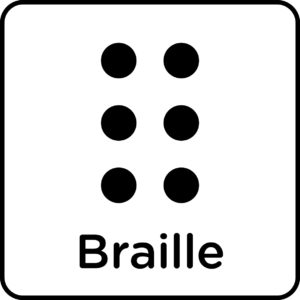Introduction to ADA Accessibility Symbols
When ensuring accessibility at your business, it’s important to stay on top of the latest requirements and guidelines or hire an expert who does this already. For us in the signage industry this is incredibly essential for us and our clients, so when we design ADA signs we have in-house experts who know what is allowed and what is required with regards to your signs. One element that’s especially important is the use of key symbols and icons on exterior and interior signage.
Accessibility symbols are in our everyday lives, and they’re more present in your life than you may even know. The most prevalent of these is the international symbol for accessibility. RIG Global, the organization that hosted the conference where the symbol was first designed, states that the “World Congress formally adopted the International Symbol of Access in 1969.”

From Corada.com’s Guidance on Use of the International Symbol of Accessibility Under the Americans with Disabilities Act and the Architectural Barriers Act, “a symbol other than the ISA will not comply with the ADA Standards unless it satisfies the “equivalent facilitation” provision (§103).” There has been some recent debate about a change to this symbol; however, for now no new versions have been adopted internationally.

In addition to the international symbol for accessibility, there are also other key symbols that highlight accessibility services or tools. Some of these are used on signs, print materials, and digital displays including phones, TVs, and other monitors.
Telephone with Volume Control
This symbol represents access to telephones with enhanced sound and/or volume controls.
Braille Symbol
This symbol represents print material and signage that is written in Braille.
Audio Description Symbol
This symbol represents the availability of audio services for those with are blind or have low vision.
Assistive Listening Symbol
This symbol represents access to audio systems or tools for those with impaired hearing.

Large Print Symbol
This symbol represents the availability of print material or signage in large print font.
Sign Language Interpretation Symbol
This symbol represents the availability of sign language services or individuals to assist those with impaired hearing.
Information Symbol
This symbol represents the availability of information, services, tools, or print material to aid in accessibility.
Visually Impaired Symbol

This symbol represents the availability of services or tools for those who are blind or otherwise have low vision.
This symbol represents access to a telecommunication device that helps deaf or hearing impaired individuals via a telephone system.
This symbol represents the availability of closed captioning services on a display or displays.
(Source: Disability Access Symbols)
Summary
Though ADA guidelines are routinely reviewed, and sometimes modified and newly adapted at a national and international level, these symbols have stayed fairly consistent through the years. So a basic familiarity of these icons is a wonderful start to knowing a little bit more about the world of accessibility symbols.
———————————————–
We rely on our in-house team of ADA experts to help our clients with their ADA needs, and you can rely on us too. If you need ADA signage for your business, you can call us at Ortwein Sign 1-866-867-9208 or leave a message for us here: https://ortweinsign.com/contact-us/.







